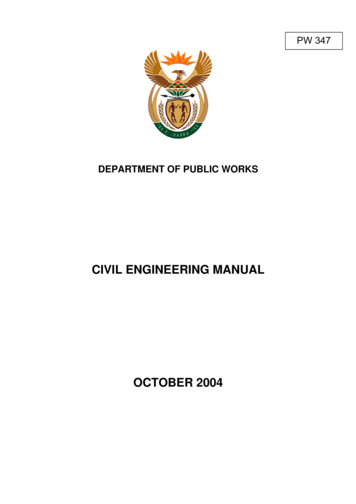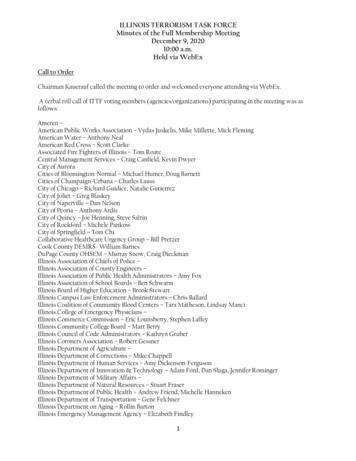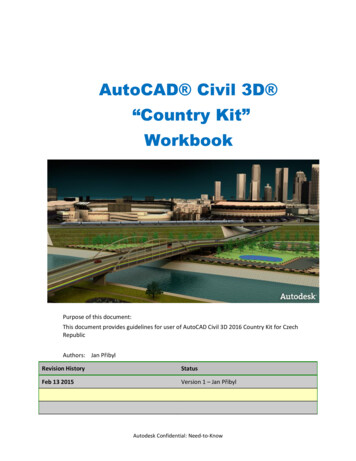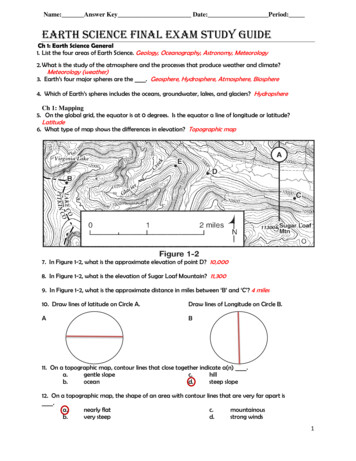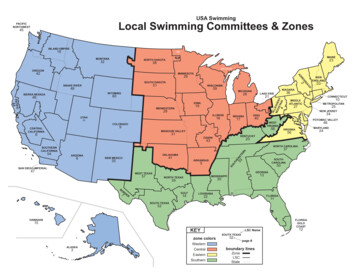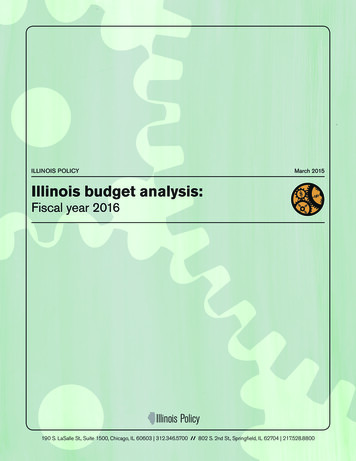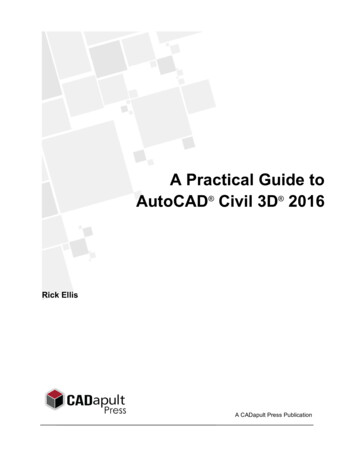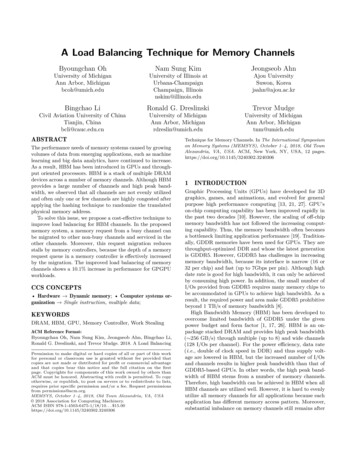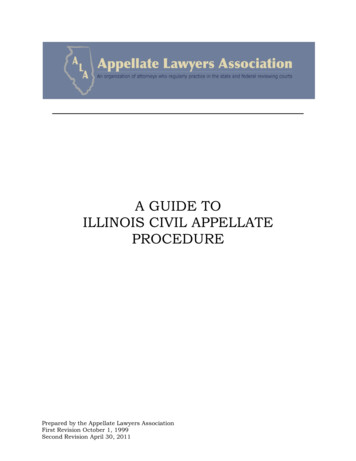
Transcription
A GUIDE TOILLINOIS CIVIL APPELLATEPROCEDUREPrepared by the Appellate Lawyers AssociationFirst Revision October 1, 1999Second Revision April 30, 2011
Copyright 2011, 1999By Appellate Lawyers AssociationAll rights reserved.All Rights ReservedAuthorization to reprint items for inclusion in a publication for sales or to photocopyitems for educational use may be obtained from the Appellate Lawyers Association bycontacting Christine Teed, 1755 Park Street, #260, Naperville, Illinois 60563, (630) 416-1166.This publication is designed to provide information in regard to the subject mattercovered. It is distributed with the understanding that the publisher is not engaged inrendering legal or other professional services. If legal advice or other expert assistance isrequired, the services of a competent, professional attorney should be sought.i
PrefaceThis guide to appellate procedure was first prepared by the Appellate LawyersAssociation in 1989 to help civil litigants who were handling their own appeals. Such litigantsare commonly called pro se litigants; pro se literally means “for oneself.” Prior to the 1999revision, the guide was titled “A Guide to Illinois Civil Appellate Procedure for the Pro SeLitigant.” Because the Appellate Lawyers Association believes the guide has evolved into amanual that is also useful to lawyers engaged in appellate practice, the title no longer indicatesthe work is directed to the pro se litigant. Nevertheless, the focus remains on the pro selitigant. The user will find that many of the references to the pro se litigant intentionallyremain in the text and in the forms.The guide is not designed to teach you how to write an effective brief or make apersuasive oral argument. Its only goal is to explain some of the procedural rules you need toknow to get your appeal to a decision on the merits. The guide is based on Illinois SupremeCourt Rules 301 through 384 in effect on April 30, 2011. These procedural rules areapplicable to all civil appeals in Illinois. Appeals in criminal cases are not dealt with in thisguide. In some areas the procedural rules in criminal appeals are not the same as the rules forcivil appeals. Illinois Supreme Court Rules 601 through 651 contain the rules for criminalappeals.The Supreme Court amends its rules from time to time, so you should always consultthe most recent version. The most current version can be found on the Court’s website atwww.state.il.us/court, click on “Rules.” Also, a few procedural rules vary among the differentappellate and circuit courts. The individual rules of the court with which you are dealing mustbe followed, and if you have any questions regarding procedures, you must follow thedirections given to you by the particular court. The local rules for each appellate court districtalso can be found at www.state.il.us/court, click on “Courts,” then “Appellate,” and then“Appellate Court Local Rules.” Wherever possible, variations are indicated in the guide.If you are handling your own appeal not by choice but because you cannot afford orcannot find an attorney, you should be aware that there are organizations which may help you.Information may be available through state and local bar associations or at the circuit orappellate court clerks’ offices. Contact information for the appellate court clerks can be foundin the Appendix and in the supreme court’s website at www.state.il.us/court, click on “Courts,”then “Appellate.”This guide is available, free of charge, at the Appellate Lawyers Association website,www.applawyers.org.The Appellate Lawyers Association expresses its gratitude to Joanne R. Driscoll, Kevin M.Forde, Ltd., 111 West Washington Street, Chicago, Illinois 60602, with the assistance of Kass A.Plain, Supervisor, Appeals Unit, Juvenile Division, Office of the Cook County Public Guardian,2245 West Ogden Avenue, Chicago, Illinois 60612, for the work they did in the second revision tothis guide.ii
TABLE OF CONTENTSPageI.WHAT THE APPELLATE COURT DOES . 1A. THE COMMON LAW RECORD. 1B. THE REPORT OF PROCEEDINGS . 1C. THE PARTIES’ BRIEFS . 1II. WHEN TO APPEAL . 2A. APPEALS FROM FINAL ORDERS . 3B. JUDGMENTS AS TO FEWER THAN ALL PARTIES OR ALL CLAIMS . 4C. MATTERS OTHERWISE APPEALABLE AS OF RIGHT . 4D. MATTERS OTHERWISE APPEALABLE BY PERMISSION . 6III. STARTING THE APPEAL PROCESS—APPEALS AS OF RIGHT . 7A. THE NOTICE OF APPEAL . 7B. WHERE TO FILE . 8C. WHAT IF YOU MISS THE 30-DAY DEADLINE? . 9D. STAY OF JUDGMENT PENDING APPEAL . 101. Stay of Money Judgments . 102. Stay of Other Judgments . 103. Extension of Time to File Bond . 104. Stays by the Appellate Court . 105. Automatic Stay Pending Appeal of Termination ofParental Rights . 116. Automatic Stay – Permissive Appeals . 11IV. APPEALS BY PERMISSION . 11A. SUPREME COURT RULE 306 APPEALS . 11B. SUPREME COURT RULE 308 APPEALS . 12V. THE DOCKETING STATEMENT . 13VI. PREPARING AND FILING RECORD ON APPEAL . 14iii
A. TRANSCRIPTS OF COURT PROCEEDINGS . 141. Ordering the Transcripts . 142. Getting the Transcripts Certified . 153. Correcting Mistakes . 164. Filing by Stipulation . 165. Additional Time for Filing the Transcripts . 17B. WHAT TO DO IF THERE WAS NO COURT REPORTER—THEBYSTANDER’S REPORT OF ORAL PROCEEDINGS . 17C. PREPARATION OF THE RECORD ON APPEAL . 181. Ordering the Record on Appeal . 192. Payment of the Preparation Fee . 19D. FILING THE RECORD ON APPEAL . 191. Sending the Record to the Appellate Court . 192. Obtaining the Record for Use in Preparing Your Brief . 203. Certification in Lieu of Record . 20E. SUPPLEMENTAL RECORD . 20F. SUPPORTING RECORD . 21G. SPECIAL RULES FOR RECORDS IN CERTAIN CASES . 21VII. CHILD CUSTODY APPEALS . 21A. STARTING THE APPEAL . 22B. FILING AND SERVICE . 23C. DOCKETING STATEMENT . 23D. MANDATORY EXPEDITED DISPOSITION . 241. Special Caption . 242. Service Upon the Circuit Court . 243. Status Hearing . 244. Record . 245. Local Rules . 24iv
6. Due Dates for Briefs for Supreme Court Rules 301 and 304(b)(6) Appeals . 257. Due Dates for Briefs for Rule 307(a)(6) Appeals . 25E. ORAL ARGUMENT . 25F. AFTER THE APPELLATE COURT RULES . 25VIII. APPEALS FROM FINAL ADMINISTRATIVE ORDERS . 26A. PETITION FOR REVIEW . 26B. PREPARING AND FILING THE RECORD FOR REVIEW . 27IX. PREPARING AND FILING THE APPELLANT’S BRIEF . 28A. TIME FOR FILING . 28B. FORMAT OF THE BRIEF . 281. Technical Matters. 282. Brief Cover . 293. Points and Authorities . 294. Nature of the Case . 295. Jurisdictional Statement . 296. Issue(s) Presented for Review . 297. Statement of Facts . 298. Standard of Review . 309. Argument. 3010. Conclusion . 3011. Certificate of Compliance . 3012. Appendix . 30C. FILING AND SERVICE OF APPELLANT’S BRIEF . 31D. REFERENCE TO PARTIES . 31E. RESEARCHING THE LAW FOR YOUR BRIEF (for pro se litigants) . 311. Deciphering Legal Citations . 312. Finding the Law . 32F. EXTENSION OF TIME FOR FILING BRIEFS . 33v
X. PREPARING AND FILING THE APPELLEE’S BRIEF. 34A. APPEARING AS APPELLEE . 34B. CHECKING THE RECORD FOR COMPLETENESS . 34C. TIME FOR FILING . 34D. FORMAT OF THE BRIEF . 351. Technical Matters. 352. The Cover . 353. Points and Authorities . 354. Nature of the Case . 355. Jurisdictional Statement . 356. Statement of the Issues . 357. Statement of Facts . 358. Standard of Review . 359. Argument. 3510. Conclusion . 3511. Certificate of Compliance . 36E. FILING AND SERVICE OF APPELLEE’S BRIEF . 36XI. PREPARING AND FILING APPELLANT’S REPLY BRIEF . 36A. TIME FOR FILING . 36B. FORMAT OF THE REPLY BRIEF . 36C. FILING AND SERVICE OF THE REPLY BRIEF . 36XII. ORAL ARGUMENT . 36A. COURTROOM DEMEANOR. 37B. THE CONTENT OF YOUR ARGUMENT . 37XIII. AFTER THE APPELLATE COURT ISSUES AN OPINION . 38A. PETITION FOR REHEARING . 38B. PETITION FOR LEAVE TO APPEAL . 381. Format of the Petition . 38vi
a. Technical Matters . 39b. The Cover. 39c. Prayer for Leave to Appeal . 39d. Statement of Date Upon Which Judgment Was Entered . 39e. Points Relied Upon For Review . 39f. Remainder of Petition . 392. Filing and Service of the Petition . 393. Responding to the Petition . 394. If the Petition is Granted . 40a. Notice of Election. 40b. Standing on Petition as Appellant’s Brief . 40c. If You File an Appellant’s Brief . 40d. Reply Brief . 40APPENDIXClerks’ Offices – Illinois Supreme and Appellate Courts . A-1Timelines. A-2 to 10Exhibitsvii
I.WHAT THE APPELLATE COURT DOESC. THE PARTIES’ BRIEFS. These arewritten pleadings filed in the appellatecourt by the parties to the appeal. Theyexplain to the appellate court: (a) what thecase is about; (b) what happened in thecircuit court; (c) what the appellant believeswas wrong with the circuit court’s decision;(d) the legal reasons why that decision iswrong, supported by appropriate citationsto existing law; and (e) why the party on theother side (the appellee) believes the circuitcourt’s decision was correct.The reasons for the rules of appellateprocedure are easier to understand if youhave some idea how the appellate courtoperates and what it can and cannot do foryou. The appellate court’s function is toreview what has already happened in thecircuit court and decide, based on theissues raised, whether any legal errorsoccurred in those proceedings. In order todecide that, the appellate court can lookonly at what happened in the circuit court.It does not hear evidence by live witnesses,and it cannot consider anything that wasnot presented in the circuit court.Inaddition, it is not the appellate court’sfunction to search for errors. The appealingparty (the party who lost in the trial court iscalled the appellant) must tell the courtwhat the claimed error is, and why whathappened was contrary to the law. Whenthe party is representing himself or herself,he or she is called a pro se litigant.Most of the rules of appellate proceduredeal with getting these documents filed inthe appellate court in the proper form andin a timely fashion, so they can beconsidered by that court.Once everything is filed, the appellatecourt judges have basically everything theyneed to decide an appeal. The court may,but is not required to, allow the parties topresent oral arguments about the case(typically 10 to 20 minutes is allowed toeach side). Oral argument is rarely grantedwhen one of the parties is pro se, that is,representing himself or herself.If oralarguments are to be heard, the parties’attorneys are notified when to appear beforea panel of three justices who not only listento what they have to say, but usually askquestions about the case.Because the appellate court’s review islimited to what happened in the circuitcourt and the claims of error that theappellant raises and argues, almosteverything considered by the appellatecourt is contained in three categories ofwritten documents:A. THE COMMON LAW RECORD. Thisincludes all the pleadings, motions andother written documents the parties filed inthe circuit court during the course of theircase (for example, complaints, answers,motions to dismiss or for summaryjudgment). It also includes all the writtenorders entered by the circuit court judge.After reading the briefs, reviewing therecord, considering applicable law, andlistening to oral arguments (if the court hasdecided that oral argument is necessary),the three justices assigned to consider theappeal discuss the case among themselves,reach a decision, and file a written decision(an opinion or an order). All three justicesmust consider the case.If all are inagreement, one of them writes the decision,and the other two “concur,” that is, theyshow their agreement by signing theirnames. If one of the justices does notB. THE REPORT OF PROCEEDINGS.Also referred to as the transcript ofproceedings, this is the written record oforal proceedings (for example, trialtestimony and oral arguments on motionspresented to the circuit court) that isprepared by the court reporter.These,together with the common law record, makeup the record on appeal. 1such as papers and photographs, if the circuitcourt considered them and if they are importantto the appeal. Oversized exhibits will not beincluded in the record except upon order of theappellate court entered on the court’s ownmotion or pursuant to motion of any party.Sometimes the appellate court will considerexhibits of a descriptive or documentary nature,1First Revision October 1, 1999Second Revision April 30, 20111
agree, he or she will file a written “dissent”explaining the basis for the disagreement.The decision agreed upon by two or morejustices is the judgment of the court.when the fee for preparing the record mustbe paid and how you will receive noticewhen the record is ready.Similarly,employees of the offices of the appellatecourt clerks will answer any questions youmight have regarding how many copies of amotion must be filed, whether the justiceshave ruled on a pending motion, andwhether a date has been set for oralargument.The powers of the appellate court arelisted in Supreme Court Rule 366. The ruledescribes the type of relief the court maygrant; for example, reversing a judgmentand entering judgment for the other party,or vacating an order and sending the caseback to the circuit court for furtherproceedings. It also limits, to some extent,the issues that can be reviewed.Forexample, it provides that where there hasbeen a jury trial, the party appealingcannot raise on appeal any claim of errorthat was not raised in a post-judgmentmotion before the circuit court.Please bear in mind, though, that whilemany of the clerks are lawyers, most of theemployees that you will deal with in theiroffices are not. They are all prohibited fromgiving legal advice. They can tell you whattheir particular technical procedure is, butthey cannot fill out forms for you, preparenotices of appeal for you, draft motions foryou, or advise you in any way regardingyour appeal.Filing the record and your briefs on timeand in a form the justices will consider isthe most important part of your appeal.The Supreme Court Rules tell you whenand how to do that, beginning with thefiling of your notice of appeal through thefiling of your briefs.Those Rules arediscussed in this guide.II. WHEN TO APPEALThe “when” of an appeal is governed bySupreme Court Rules 301 through 308.The most basic rule, and the one mostlikely to affect pro se litigants, is that onecan appeal (a) from final judgments thatend the case (Supreme Court Rule 301); or(b) in cases involving multiple parties ormultiple claims, when the circuit courtjudge enters an order that ends thelitigation as to one or more (but fewer thanall) parties or claims and expressly findsthat the ruling can be either appealed orenforced (or both) immediately (SupremeCourt Rule 304(a)).Other types ofjudgments or orders from which appealscan be taken as of right are set forth inSupreme Court Rules 304(b) and 307.Certain orders can be taken by permissionpursuant to Supreme Court Rules 306 and308. Each of these types of appeal isdiscussed in greater detail below.The Role of the Circuit and AppellateCourt ClerksThis is an appropriate place to explainthe different roles played by the offices ofthe circuit and appellate court clerks in theappeal. The office of the circuit court clerkaccepts and files your notice of appeal andassembles the record to be transmitted tothe appellate court.The office of theappellate court clerk accepts and files therecord and the briefs. The appellate courtclerk also makes sure that everything isfiled in a timely fashion, keeps track of themany cases pending on appeal, recordsrulings on motions issued in those cases,and provides notice to the parties of thedate for oral argument and the date onwhich a decision will be issued in the case.It is very important to know when to fileyour notice of appeal because the failure tofile within the time allowed almostinvariably leads to dismissal of your appeal.This is not a matter for the appellate court’sdiscretion. If your appeal is not filed ontime, the appellate court cannot consider itbecause it has no jurisdiction to do so.You will find the employees of theclerks’ offices most helpful in providinginformation within the areas of their duties.For example, you can ask an employee ofthe office of the clerk of the circuit courtFirst Revision October 1, 1999Second Revision April 30, 20112
A. APPEALS FROM FINAL ORDERSresult of a jury verdict, you must file a postjudgment motion in the circuit court topreserve any error for review by theappellate court.With other types ofjudgments, a post-judgment motion is notusually necessary. After the circuit courtrules on the post-judgment motion, yourappeal must be filed within 30 days afterthe ruling and the time is calculated thesame as described above.Be careful,though. You cannot put off the time forappeal by filing one motion after another inthe circuit court once a final order has beenentered.When the circuit court hasentered its judgment, you are permittedone, and only one, post-judgment motionasking the court to consider its ruling oroverturn the jury’s verdict. Once that isruled on, you must appeal within 30 daysor the case is over.Supreme Court Rule 301 provides aright to appeal from all final judgments ofthe circuit court in civil cases. A “finaljudgment” is one that completely disposesof the entire case, for example an orderdismissing the whole complaint “withprejudice,” or an order granting summaryjudgment as to all defendants, or an orderentering judgment on a jury verdict (or onthe trial judge’s findings in cases triedwithout a jury). A judgment is final whenthere is nothing more for the circuit courtto do on the case. Your notice of appealmust be filed within 30 days from the datethat final judgment is entered. SupremeCourt Rule 303(a)(1). If the judge rulesorally, but requires that a written orderreflecting his or her ruling be prepared andfiled, then the 30-day period for filing theappeal runs from the date the written orderis entered by the court.Some pro se litigants wonder why theyhave to wait until the end and cannotappeal every adverse ruling of the circuitcourt at the time it is made. There are tworeasons for that rule.In counting the 30 days, you do notcount the date the judgment is entered.For example, if the circuit court grantssummary judgment on May 9 (the date onthe written order), May 10 is day 1; June 8is day 30.Saturdays, Sundays, andholidays must be counted. You must fileyour notice of appeal on or before June 8.You can file your notice of appeal beforeJune 8, but not later, unless the 30th dayfalls on a Saturday, Sunday or courtholiday (e.g., Thanksgiving Day, ChristmasDay, July 4th). In that case, your notice ofappeal must be filed on the very next daythe court is open for business.Forexample, if June 8 falls on a Sunday, thenyour notice of appeal would be consideredtimely if it is filed on Monday, June 9.1. Suppose John Doe is injuredusing a product that he bought at XHardware Store. He sues the store andthe manufacturer of the product, AcmeManufacturingCompany,makingclaims of both negligence and strictproduct liability.The circuit courtgrants summary judgment for XHardware on his strict product liabilityclaims. Doe wants to appeal, but hecannot because the judgment is not“final.” He still has to go through a trialon his two claims against Acme and theoneremainingclaimagainstXHardware. Suppose further that thecase is tried, and the jury returns averdict in Doe’s favor against both Acmeand X Hardware and awards him all thedamages he asked for. It would notmake any sense for Doe to appeal thesummary judgment in favor of XHardware on that one claim, because hehas gotten everything he wanted. Soreason number one is that, in the longrun, the order that seems so importantnow may not make any difference oncethe case is over.The circuit court cannot extend the timeto appeal in any circumstance. However,the filing of a post-judgment motion within30 days of judgment (for example, a motionto reconsider or a motion for a new trial)will toll (that is, delay) the time to appeal.When a timely post-judgment motion isfiled, the time for appeal does not begin torun until the circuit court rules on thatmotion.Supreme Court Rule 303(a)(2).When the circuit court’s judgment is theFirst Revision October 1, 1999Second Revision April 30, 20113
2. You should also keep in mindthat many orders are entered during thecourse of an action in the circuitcourt—orders about discovery, ordersstriking or dismissing various counts ofa complaint, orders in favor of some butnot all defendants. An appeal from justone order can take as long as one year,depending on the backlog in theappellate court and how timely theparties file their briefs.Permittinglitigants to appeal from every singleorder entered in the litigation as soon asit is entered would prolong a case andcreate an impossible backlog in thecourts. Reason number two, then, isthat usually it just is not efficient topermit several appeals in a case whenany and all claimed errors can beconsidered at one time in a singleappeal.the order is not final even though there isnothing more to be done with Doe’s strictproduct liability claim.In order to make such an orderimmediately appealable, the circuit courtwould enter a written finding that there is“no just reason for delaying eitherenforceme
This guide to appellate procedure was prepared by the Appellate Lawyers first Association in 1989 to help civil litigants who were handling their own appeals.

